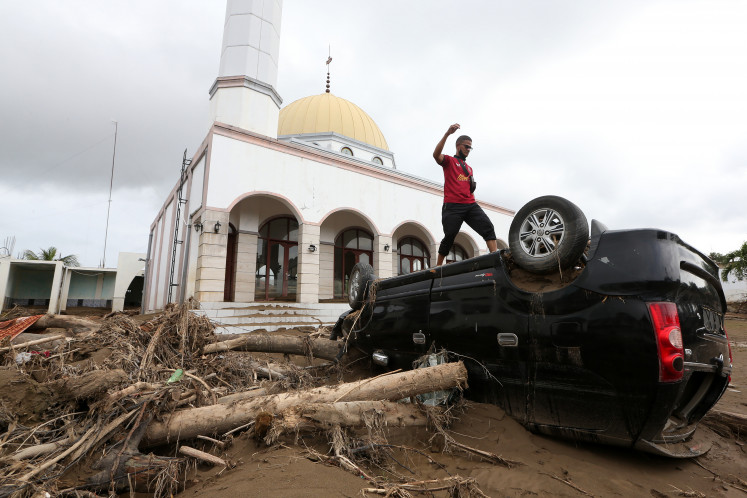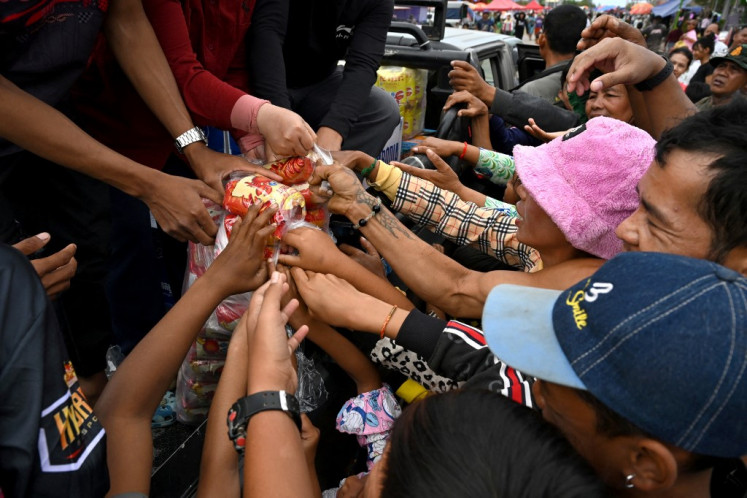Popular Reads
Top Results
Can't find what you're looking for?
View all search resultsPopular Reads
Top Results
Can't find what you're looking for?
View all search resultsBrahu temple, a mystery still standing
Standing at a height of some 10 meters, the grandeur of Brahu temple is awe-inspiring, challenging the viewer to discover the mysteries it holds
Change text size
Gift Premium Articles
to Anyone
Standing at a height of some 10 meters, the grandeur of Brahu temple is awe-inspiring, challenging the viewer to discover the mysteries it holds.
The history of Brahu temple, which is located in Bejijong village, south of Mojokerto, East Java, is still shrouded in mystery. (JP/Retno K. Djojo)
That is not easy, though, as a lack of information about the temple's past has long puzzled historians and archeologists. The terracotta temple of Bejijong village, East Java, is still shrouded in mystery.
Historical records do not reveal any name or time reference clue's of the temple's past, but its location and brick composition suggests it was part of a cluster of temples of the historic Trowulan, the seat of the 13th century Majapahit Hindu kingdom.
The temple, currently undergoing restoration, sits in the middle of a green park.
Unlike older or contemporary temples in East Java, Brahu lacks any reliefs or statues such as a deity or a ruler that could be used to peep into its past.
But the serenity it emanates adds to its grandeur and magnificence as a historic monument. Its facade is adorned with fillets, accentuating its unique bell-shaped curves, which themselves are laced in elaborate patterns.
Archeologists studying the upper part of the temple discovered the remnants of a dome, suggesting the temple was previously topped with a dome roof.
Historians have also surmised Brahu temple has strong Buddhist influences.
A plaque excavated in the vicinity of the temple dates back to before the Majapahit era and indicates that on the same site once stood a temple known as Warahu. Some researchers think Brahu could be a derivative of Warahu, which means a place to keep the ashes of the deceased.
The plaque, which dates back to the year 939 A.D., may indicate that the rulers of the Majapahit kingdom built Brahu upon the remains of a much older temple, also functioning as a chamber for the ashes of the deceased.
The double terrace that forms the foot of the temple's body also indicate the upper terrace was built upon an older structure.
Brahu temple was already severely damaged when it was uncovered in the early 20th century. Restoration work began in 1920 on an area measuring 10 by 10.5 square meters with a height of 9.6 meters.
Neither its dome-shaped roof nor a staircase could be restored. The floor of the temple's chamber measuring four by four meters is entirely damaged, making it difficult to determine whether the chamber was previously used as an area to hold human remains.
Archeologists have found traces of carbon scattered over the damaged floor. A small table, built into the wall, may have been used for offerings.
Restoration work continued from 1990 through 1995 to reinforce the temple's terraces, which were showing signs of giving way. This second phase of restoration cost some Rp 650 million and resituated the temple at the center of the park.










